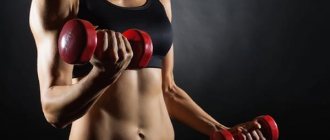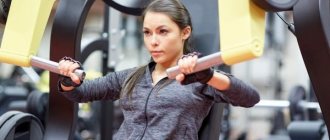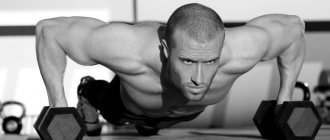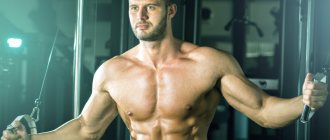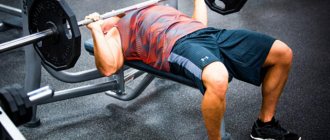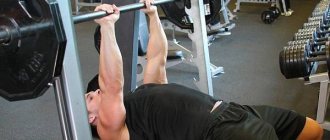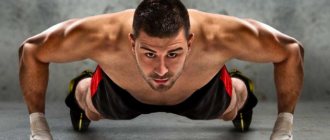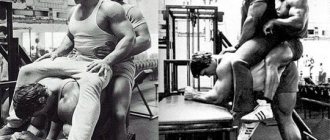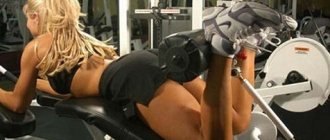Hello dear reader! Today we’ll talk about increasing muscle mass in the shoulder girdle. The deltoids have secured their status as muscles that are difficult to pump. This is due to the fact that it is difficult to “feel” the shoulders and include them in the work. In addition, muscle growth and the amount of testosterone decreases with age, making it more difficult to make shoulders massive. Therefore, for maximum effect, you need to start pumping deltas as early as possible.
Massive, broad shoulders are the first thing people around, especially girls, pay attention to. Therefore, shoulder push-ups are a must have for every young guy or adult man. In this article I will tell you about an easy way to gain large muscles using delt push-ups.
What kind of exercise is this
Push-ups are a simple lifting of the torso in a lying position. A special stance is used to engage the deltoid muscles. It is distinguished by a narrow position of the arms and elbows pressed to the body.
In training, variations of this exercise are used, including the front, middle or rear groups of deltas.
What muscles work
With the correct positioning of the body and palms, the upper bundles of deltas are pumped first. In this case we are talking about the anterior and middle deltas. The rear one is involved in the work to a lesser extent.
Other groups are also working on push-ups. This is a universal workout for increasing pectoral muscles, triceps, stabilizers, and endurance.
Benefits and harms
Push-ups, like any exercise, can be useful under certain conditions:
- General strengthening activity. In terms of the number of push-up groups included in the work, they are not inferior to squats and pull-ups on the horizontal bar. It’s not for nothing that they are included in the list of basic bodyweight exercises.
- Stabilizer training. When doing push-ups, you strengthen the muscles responsible for stabilizing your arms and core. Powerful stabilizers are the key to good coordination and strength.
- Press. By doing a lying position, you also use your abdominal and abdominal muscles.
- Body endurance. Push-ups are considered an anaerobic exercise. However, a large number of repetitions and approaches improves the functioning of the cardiovascular system and increases endurance.
- Increased strength. Push-ups can increase the strength of the muscle tissues of the chest and arms in a short time. That is why this exercise is the basis of many army and bodybuilding programs.
Push-ups are considered harmful due to the increased stress on the wrists, which leads to joint-related diseases. Problems will begin if you do not use arm bandages or special cuffs when performing these exercises frequently with weights.
Also, the disadvantages of push-ups include incomplete development of the rear and middle deltas.
Contraindications
There are contraindications for performing push-up exercises while lying down:
- High blood pressure due to body position.
- Diseases of joints and tendons. Push-ups are a multi-joint exercise. Therefore, people with problems in the wrists, elbows and shoulders are contraindicated to perform them.
- Overtraining of the body. You should not overuse push-ups - you will get tired, and catabolism will begin after a large number of approaches.
Content
- 1 Military push-ups 1.1 Half push-ups
- 1.2 Push-ups on a flask
- 1.3 Push-ups with feet on helmet
- 1.4 Push-ups with offset arms
- 1.5 Push-ups with rearrangement of hands
- 1.6 Push-ups with helmet for 6 counts
- 1.7 Rearranging hands in a prone position
- 1.8 Shoulder Touch Push-Up
- 1.9 Push-up into caterpillar
- 1.10 Push-ups with knee to elbow
- 1.11 Explosive Plyometric Push-Up
- 1.12 Plyometric push-ups with helmet
Is it possible to build bigger shoulders at home with push-ups?
You can and should strengthen your shoulders at home with push-ups. For maximum effect, you need a whole system:
- Consistency.
- Determination.
- Workout.
- Nutrition.
- Dream.
This will allow you to build strong and voluminous deltoids, even if you don’t go to the gym.
Of course, it is difficult to achieve stunning results with basic push-ups. To do this, experienced athletes use isometric types of such training. This allows you to focus the load on a specific group and increase the effectiveness of the exercise.
Dependence of load on body inclination
In the classic version of push-ups, the legs and arms are on the floor, and during the movement the body takes a position parallel to the floor. Depending on how we place our hands, we can force the pectoral muscles (palms wide) or triceps (palms narrow) to work the most. But what happens if we raise our legs above our heads, or, conversely, put our hands on a stand?
Legs on support
When the legs are higher than the head, the weight of the body is mainly on the arms, and the arms are known to be smaller and weaker than the legs. Therefore, this type of push-up is a complicated variation of the classic exercise. You should include such push-ups in your training program if you have already mastered the basic push-ups to perfection.
In fact, the leg-up push-up is an inverted version of the bench press with a positive incline. At the same time, the upper part of the chest is emphasized. More specifically, the load distribution looks like this:
- pectoral muscles (emphasis on the upper part);
- deltoid muscles (anterior bundles);
- triceps;
- the abs and back muscles work statically.
Also, the higher you place your legs, the more your deltoids are activated. If we continue to lift our legs and get to the handstand push-up, it is actually a shoulder exercise.
The optimal inclination of the body for developing the upper chest is 30-45 degrees at the lowest point (chest near the floor). That is, in the starting position, it is enough to place your legs on a bench or fitball. With the latter option, the body is also actively working.
Hands on support
When we place our hands above our feet, that is, on a bench or stand, most of the body weight falls on our feet. And this is a completely natural state of affairs; every day we carry all our weight on our legs alone. Accordingly, this version of the exercise is much easier than legs above the head.
This type of push-up is well suited for beginners who still find the classic version of the exercise difficult.
Why do this easy thing, an experienced athlete will ask? The answer is simple - the exercise perfectly engages the lower part of the pectoral muscles. Therefore, if for some reason this area is lagging behind you, you can purposefully work on its development. So that life doesn’t seem like honey, we take a weight in the form of a backpack or vest.
The load distribution looks like this:
- pectoral muscles (emphasis on the lower part);
- triceps;
- the muscles of the abs, back and legs experience static tension.
Technique and types of exercises
Let's look at three types of the most effective delt push-ups without dumbbells:
- Floor press. A popular option for working out the shoulders. The method is suitable for beginners. Does not require special skills, flexibility or acrobatics. Hands are placed at shoulder level, feet together. It is important to lower your body deeper, until a right angle is formed at the elbow. The disadvantage is the use of the chest and triceps. They will take part of the payload.
- Corner push-ups. Take a lying position and place your feet closer to your hands so that your legs and torso form a right angle. The feet stand on their toes. From this semi-vertical position, begin to do push-ups, lowering yourself along a long amplitude to the floor. In the corner exercise, three bundles of deltoid muscles are involved at once and the load on the arms is reduced. Change the load by changing the distance between your toes and palms.
- Vertical support while lying down. You take the position lying upside down against the wall, palms on the floor. Start doing push-ups, lowering the top of your head to the ground. This type of training is for experienced athletes and requires some acrobatic skills. At the same time, you will feel how the three deltoid bundles work, and you will pump only them. If you want to learn this type of push-up, try standing on your hands against a wall first.
Other types of push-ups do not isolate the shoulders as clearly, but are suitable for pumping up stabilizers:
- Shoulder push-ups. A standard stand is accepted. The amplitude is created by bringing and lowering the shoulder blades without bending the arms.
- Exercises on one leg. To increase the load on your upper body, remove one leg from the stance.
- T-push-ups. When doing push-ups, lift your arms one at a time. At the same time, lift each one up, maintaining the balance of the second. This will further strain the abdominal muscles.
- Reverse push-ups. In this case, the hands are placed on a bench or other elevation, the feet are on the heels. Lower your torso to a right angle between your elbow and forearm. The exercise primarily develops the triceps, but also puts stress on the shoulders.
Is it possible to build muscles by doing push-ups?
Before you begin any type of training, you need to decide on your end goal. The same rule works with push-ups.
When performing the element, the pectoral, deltoid and triceps muscles are activated. Depending on the type of presses, the load on one of these groups is adjusted, and smaller bundles and tendons are added. It is these departments that are pumped up during this exercise.
Beginners are often faced with a situation in which they do push-ups every day, but do not observe a visible increase in muscle mass. The fact is that in this case muscle endurance increases, not their size. For a significant increase in mass, it is necessary to use additional weight, which will promote micro-tears.
Be sure to watch: Gallery image with caption: Push-up program: recommendations and plans Gallery image with caption: All the benefits of push-ups: different options for physical activity Gallery image with caption: Push-ups from the floor: optimal programs for exercising at home Gallery image with caption: Push-ups for girls: an effective way to pump up the female body or “male prerogative”
Example workout
Below is a sample of exercises at home and in the gym.
At home
It is possible to exercise at home, since training does not require special equipment.
Here is a set of exercises:
- Warm up. To avoid injury, perform warm-up exercises: swing your arms in a circle 10-20 times, raise your arms to the sides 10-20 times, move in a circle with your hands on your shoulders 10-20 times, and at the end, gently stretch your arms and shoulders.
- Shoulder push-ups – 4 to 15 – 30.
- Pushups. Hands shoulder-width apart, elbows close to the body: 4 sets of 6 – 15 push-ups.
- Corner push-ups - 4 sets of 6 - 15 times. Don't forget to adjust the height of the stand.
- Single leg push-ups – 3 x 6 – 12 reps.
- Hitch. At the end, swing your arms: in front of you, to the sides - 3 x 15 - 30 repetitions.
In the gym
When training in the gym, use additional equipment. For example, place your feet on a weight, bench, or ball. This will increase the load on your shoulders.
Also, do barbell squats before working your shoulders. The squat works more muscle groups than any other exercise. By doing it, you will trigger a surge in testosterone, which will have a positive effect on shoulder growth. Perform 3-4 sets of 10 repetitions with medium weight.
Here is a set of exercises:
- Warm up. To warm up, you will need a block trainer or elastic band. Bend your elbow at a right angle. Hold an elastic band or the handle of a block in your palm so that the axis of the load runs parallel to your forearm. Perform hand abduction and abduction - 4 sets of 15-20 repetitions for each arm.
- Shoulder push-ups - 4 sets of 6 - 15.
- Corner push-ups - 4 sets of 6 - 15 times.
- Vertical push-ups or t-push-ups – 4 x 6 – 15 reps.
- On one leg - 3 x 4 - 12 times.
- Hitch. Stretch your arms and deltoids in a butterfly machine or on a bench with dumbbells - 3 x 10-15. Use light weight.
Push-ups with wide arms[edit | edit code]
This option for positioning the arms changes the distribution of the load, allowing you to load predominantly the pectoral muscles, while the muscles of the arms and shoulder girdle are used to a lesser extent.
Starting position: Take the position “support on straight arms”, but place your hands at a distance exceeding the width of your shoulders by 20-30 cm. Make sure that your elbows do not go beyond the line of your hands. Tighten your abdominals to keep your entire body in line from your shoulders to your feet. Don't lift your pelvis up or let your back sag down.
- As you inhale, lower your body until the angle of your elbows is approximately 90 degrees and your chest is 3-5 cm from the floor.
- As you exhale, press your body up, straightening your arms. Imagine yourself rising up, trying to push the floor away from you. The pushing force should come primarily from the muscles of the shoulder girdle and chest.
This variant of the placement of the hands allows you to work primarily the triceps and, to a lesser extent, the muscles of the chest and shoulder girdle.
Starting position: Take the position “emphasis on straight arms”, but place your hands directly under your chest, a few centimeters from each other. The feet can be slightly spread to the sides to make it easier to maintain balance.
- As you inhale, lower your body until the angle of your elbows is approximately 90 degrees and your chest is 3-5 cm from the floor. Keep your elbows close to your torso.
- As you exhale, press your body up, straightening your arms. Imagine yourself rising up, trying to push the floor away from you. The pushing force should come primarily from the triceps, shoulder muscles and chest.
Correct fingertip push-up technique
This option strengthens the muscles of the chest, hands and forearms.
Starting position: Take a straight arms position, but give your hands a “bear paw” appearance so that only your fingertips are in contact with the floor. The distance between the hands should be slightly wider than the shoulders.
- As you inhale, lower your body until the angle of your elbows is approximately 90 degrees and your chest is 3-5 cm from the floor. Keep your elbows close to your torso.
- As you exhale, press your body up, straightening your arms. Imagine yourself rising up, trying to push the floor away from you. The pushing force should come primarily from the muscles of the shoulder girdle and chest.
Very similar to push-ups with a narrow arm position, this option develops the triceps well and, to a lesser extent, the muscles of the chest and shoulder girdle.
Starting position: Take a push-up position, but place your hands so close to each other that your index fingers and thumbs touch each other and form a diamond-like figure.
- As you inhale, lower your body until your chest is as close to your hands as possible. Keep your elbows close to your torso.
- As you exhale, press your body up, straightening your arms.
A surprising number of people complain that regularly doing push-ups causes discomfort in their wrists, but if you clench your hands into fists, the weight of your body will rest on your knuckles instead of your palms, which will help you avoid straining your wrists as you perform the movements.
Starting position: Take a straight-arm position, but instead of your palms, press the knuckles of your fists, turned perpendicular to your body, into the floor.
Note. Please, when performing this type of push-up, place something soft under your fists: a gymnastic mat or a folded towel.
- As you inhale, lower your body until the bend angle of your elbows is approximately 90 degrees and your chest is 3-5 cm from your hands. Keep your elbows close to your torso.
- As you exhale, press your body up, straightening your arms. Imagine yourself rising up, trying to push the floor away from you. The pushing force should come primarily from the muscles of the shoulder girdle and chest.
This explosive, or plyometric, exercise further develops the muscles of the shoulder girdle, chest and triceps.
Starting position: Take a push-up position. Your legs can be slightly spread to the sides to make it easier to maintain balance.
- Lower your body until your elbows are at approximately 90 degrees and your chest is 3-5 cm from your hands.
- Without stopping, throw your body up with a sharp jerk. When your hands leave the floor, quickly clap your hands and return your hands to the starting position before landing.
The additional challenge of this type of push-up is the need to maintain balance, maintain core stability and apply more effort.
Starting position: Take a straight-arm position, but place one foot on top of the other so that only the toe of the bottom foot is in contact with the floor.
- As you inhale, lower your body until the bend angle of your elbows is approximately 90 degrees and your chest is 3-5 cm from your hands. Keep your elbows as close to your body as possible.
- As you exhale, press your body up, straightening your arms. Imagine yourself rising up, trying to push the floor away from you. The pushing force should come primarily from the muscles of the shoulder girdle and chest.
We invite you to familiarize yourself with the Diet for Flatulence
This type of push-up strengthens the triceps, chest and forearms.
Starting position: Take a push-up position, but spread your legs slightly wider than shoulder-width apart. Lift one hand off the floor (the weaker one) and place it behind your back.
Note. Don't attempt one-arm push-ups until you've gained enough experience doing regular push-ups.
- To maintain balance, turn your torso slightly in the direction opposite to your supporting arm. As you inhale, lower your body until your chin is a few centimeters off the floor.
- As you exhale, press your body up, trying to keep your back straight. Stop before your arm is fully extended.
Training Tips
Having set yourself the goal of having beautiful shoulders, go ahead, but follow some rules.
Sets and reps
Don't chase too many reps. To increase muscle mass and strength, it is better to make the work more difficult as you go. Ideally, do one set of challenging weights at the end of your workout.
The number of repetitions per approach to start the anabolic process is 6 - 15.
Weights
The right option would be to increase the complexity of the approach. To do this, use weights.
For training at home, choose accessories from a sports store. Feel free to take bags or elastic bands in the hall. Don't rush to the gym.
Watch a video of exotic push-up weight training techniques.
Nutrition and sports supplements
Don't forget that training is only a third of success. If you want to pump up your shoulders and build mass, take care of nutrition:
- Eat more protein foods (meat, fish, cottage cheese, eggs, peanuts).
- Use whey protein isolate to give you extra protein every day.
- If you are an ectomorph (prone to thin), I advise you to purchase a gainer as an additional meal.
- To avoid overtraining, consume L-carnitine or BCAA.
What to do if your shoulder hurts when doing push-ups
If your shoulder hurts, it’s worth understanding the nature of the pain’s origin.
Frequent options:
- Muscle pain. You have overloaded the muscle. Rest until the fibers recover.
- Joint pain. This is already serious. Pain in the elbows and wrists can be caused by bursitis or arthritis. If this pain persists for weeks, consult your doctor.
What to do if your shoulder hurts after push-ups
It is important to localize sensations:
- If your muscles hurt, most likely you damaged them out of habit during heavy exercise.
- If your bones are bothering you, you should consult a doctor.
Common mistakes
Everyone makes mistakes. It's unpleasant when they affect your health or make your workouts useless.
Expert opinion
Remember the main rule when doing push-ups - lower yourself to 90 degrees at the elbow, feet together, back straight, buttocks in line with your shoulder blades and heels. This is the only way to get the desired effect.
Don't rush into complex weights and exercises. Some people start straight away with wide-grip military presses at the gym, but if you're a beginner, master push-ups first. When performing technically difficult exercises, you risk injuring yourself and others.
BOSU inverted push-ups[edit | edit code]
Starting position: Grasp the handles on opposite sides of the BOSU platform and assume a straight-arm position.
- As you inhale, bend your arms to lower your body as low as possible - ideally, your chest should be 3-5 cm from the platform. Make sure that your body is a straight line from head to heels.
- As you exhale, lift your body to the starting position using the muscles of your chest, arms, and upper back. To maintain balance, engage the muscles in your midsection.
This type of push-up strengthens the muscles of the shoulder girdle and triceps, and also introduces an additional element of aerobic exercise into the workout.
Starting position: Take a plank position (lying on your elbows and toes). The entire body from head to toe should be a straight line. Maintain this position by engaging the muscles in your midsection. Make sure that your hips and pelvis do not sag.
We suggest you read: How many calories are in a bowl of oatmeal?
- As you exhale, straighten your right arm, lifting the right side of your body up.
- Then straighten your left arm. You should now be in the standard straight arms position.
- Lower yourself onto your left elbow.
- Lower yourself onto your right elbow.
Conclusion
Push-ups will make your deltoids round and sculpted. You will quickly achieve the desired results if, in addition, you follow a routine, constantly do exercises and monitor your diet. If you are a beginner or do not have access to a gym, delt push-ups and their variations will replace most exercise machines and trainers. Be sporty and healthy!
If you liked the article, subscribe so as not to miss new ones. Tell and share information with your friends on social networks. Thank you for your attention!
Is there any way to speed up muscle growth?
Concluding the publication on the topic “how to pump up your shoulders with push-ups,” we will give some practical tips to speed up the results:
- Don't neglect strength training. Push-ups mean doing exercises with your own weight. Without weights, it is impossible to build muscle relief;
- Visit the gym at least 2 times a week - work out with barbells, dumbbells, and exercise machines;
- Consult with experienced trainers to help you create an effective training program for target muscles;
- Follow a sports diet rich in proteins, minerals and vitamins;
- Choose high-quality sports nutrition for yourself.
So, we have found out that shoulder push-ups alone cannot replace a full-fledged workout in the gym. However, they are very effective as an additional load, which will increase the athlete's endurance, strength and muscle elasticity. And without these factors, not a single lesson will be carried out efficiently and effectively.
Effective classes
Deep push-ups work the muscles well due to the large range of motion; there should be no obstacles when lowering the body. You can do push-ups on stools or on two chairs, then the floor surface will not limit your movements, they can be made even deeper. Deep push-ups are performed with stands that are placed under both hands . The height should be approximately 10-20 cm, and you need to do push-ups from the floor. Exercises are even more convenient to do using special handles. They enable a person to hold his torso during push-ups from the floor at a higher level and lower himself with an optimal degree of depth.
Exercise variations may include weighted push-ups. If an athlete chooses this type, he should purchase a vest for training that has special weights (weights). Push-ups while standing on your hands can be carried out as follows: a barbell plate is placed on the back, with which the person does push-ups, but it is necessary to ensure that the object used does not fall. To do this, perform slow, but rhythmic push-ups. If you can’t cope, a backpack with a burdensome object is attached to your back.
Grasshopper push-ups will allow you to achieve beautiful arms and upper chest area. Grasshopper push-ups are performed in the following sequence:
- the person lies down on the floor;
- the legs are not too wide, but not together either;
- arms bend at the elbows;
- the body rises from the floor;
- the legs alternately bend at the knees and press against the body during the jump.
Lately, plyometric push-ups have become increasingly popular. When performing them, a person performs fast, vigorous and energetic body movements. Plyometric manipulations are performed using not too high benches. It is necessary to place 2 benches so that the distance between them coincides with the width of the shoulders.
When doing plyometric push-ups, you should simultaneously perform jumps. They may not be too frequent so as not to overstrain the muscle tissue. Jumps are allowed to be replaced or supplemented with claps.
Close grip push-ups
The task is effective for working out the delta. The technique is as follows:
- your palms should be placed as close as possible and directed slightly under you;
- Place your feet shoulder-width apart;
- When moving down, bend your elbows along the body, do not spread them to the sides.
This type of exercise has positive benefits for the inner chest, just like ring push-ups. The front delts and trapezius are worked quite hard, so they are recommended for performing at the beginning of training.
Approaches and push-ups in numbers
The number of approaches and presses depends entirely on your training goals. Where to start:
- If you need to burn fat deposits and gain relief - from 10 to 25 push-ups, 4 sets.
- If you need to stimulate the growth of the pectoral, shoulder and upper back muscles - from 8 to 13 push-ups in 4 sets.
Then we gradually increase the numbers. The guideline is to practice to the limit of what is possible, but not to the detriment. If after or during exercise you experience discomfort, unpleasant sensations or pain, and you have to make a volitional effort to continue exercising, the chosen training regimen is most likely not suitable and should be reconsidered.
Push-ups on parallel bars - an alternative to the gymnastic bench
If you are unable to develop a training regimen on your own, the most reasonable solution is not to experiment with your own body, but to turn to a professional. Even one meaningful lesson from a trainer will give more than several training sessions “by touch”.
A parting word about the benefits for the body
Even a person far from sports knows that proper physical activity has benefits for the body. Fit figures attract the attention of the opposite sex, sports reduce the likelihood of hypertension and heart attack, and delay the onset of many diseases. In general terms, floor presses benefit the entire body, especially the cardiovascular system.
Are you planning to take up martial arts? Floor presses should definitely be included in your individual training regimen. It is push-ups that strengthen the hands, especially if the exercise is performed with fists. With systematic practice of all types of push-ups, the muscles of the chest, back and abs, deltoid muscles of the shoulders, calf and intercostal muscles develop. There is also a positive effect on the spine, which is in dire need of a strong muscle corset.
Systematic push-ups develop an entire muscle group
Floor presses can have the opposite effect if performed incorrectly. For example, you definitely shouldn’t start training with additional weight loads right away. First, you need to learn how to perform the basic floor press, which your school physical education teacher so persistently suggested mastering.
